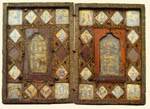|
|
| Byzantine Minor Arts |
late 13th-early14th c. St Paul Monastery Wood, metal, silver gilt, parchment, semiprecious stones, glass, pearls 30 x 41.5 x 3 cm Venice |
|

|
This diptych is enclosed in a case like a book cover; in the disposition of its ornamentation it closely resembles metal icon revetments (Loverdou-Tsigarida 1996, p. 488 fig. 314), while in technique it is closer to the 'Milutin diptych' in the Monastery of Chelandari (no. 9.29). St Paul has another two works in this same decorative style - a processional cross and an icon with Christ Pantokrator (no. 9.31) - which are also considered to be of Venetian workmanship. Indeed, they too have been associated with the owner of the Chelandari diptych, the Serb monarch Milutin (Bogdanovic - Djuric - Medakovic 1978, p. 96). In the centre of each wing of the diptych is a rectangular compartment crowned with what appears to be a gabled pediment; around these are two borders, an outer band with small lozenges and rectangles in the corners, and an inner frame of plain undecorated wood, cut to match the shape of the central compartment. Judging by the remnants of such decoration on both wings of this diptych, and by similar work on the diptych in the Chelandari Monastery, this inner band must initially have been covered with an ornamental strip of gilt filigree work and semiprecious stones. A fluted band with beaded edges sets off the individual frames on the outer band. The Dodekaorton is represented in the eight corner panels and in the central compartments. It has been suggested that the two miniatures in each of the central compartments have not been placed in the right sequence (Doelger - Weigand 1943, p. 164), since the two on the left wing, the Crucifixion and the Anastasis, seem more closely related to the four corner icons on the right, the Raising of Lazarus, the Entry into Jerusalem, the Ascension and the Pentecost; while the two from the centre of the right wing, the Nativity and the Presentation in the Temple, correspond better to the scenes framing the left wing, the Annunciation, the Nativity, the Baptism and the Transfiguration. The scene of the Annunciation is represented twice, while the Koimesis has been omitted. The sixteen lozenges on the vertical sides of the outer bands frame half-length portraits of saints, while those on the horizontal bands contain the symbols of the four Evangelists on the left wing and angels on the right. The central lozenges on each of the long sides are empty; these probably framed some inlaid ornament. Or, they may simply have been gilded and ornamented with a single semiprecious stone set in the middle, like the lozenges sections around the icons, which retain traces of gilding and in some cases a semiprecious stone. Some of the saints have been identified: on the left wing, two prophets and, below, Sts Cosmas and Damian; on the right Sts George and Theodore Stratelatis and, below, Sts Theodore Teron and Vitus. The presence of the last-named, a saint of the Roman Catholic Church, betrays a Western influence in the iconography of the diptych; some, indeed, have also seen this in the presence of the symbols of the Evangelists (Doelger - Weigand 1942, p. 164). However this may be, the miniatures are in general considered to be Constantinopolitan work, painted in the Monastery of St Andrew. These iconographic and stylistic features, together with the use of pearl accents in the compositions occupying the central compartments, link the miniatures with those ornamenting the Milutin diptych in the Monastery of Chelandari and its donor.
| |
|
Bibliography: Doelger - Weigand 1943, pp. 164-5. Sophronios 1959, p. 139, fig. 92. Huber 1969, p. 290, fig. 177. Kadas 1979, p. 111.
| ||
| K. L-T. | ||
| Index of exhibits of Monastery of St. Paul's 13th century |
||
Reference address : https://www.elpenor.org/athos/en/e218ci30.asp